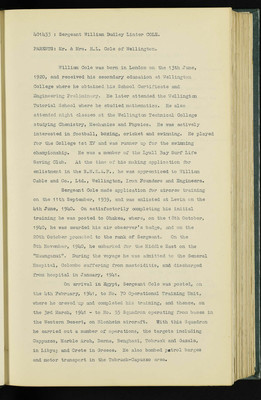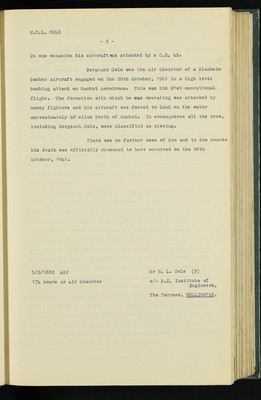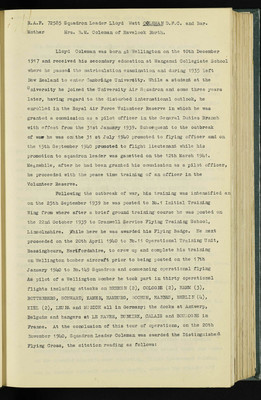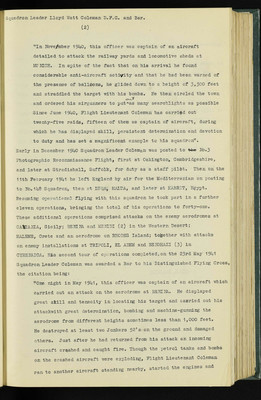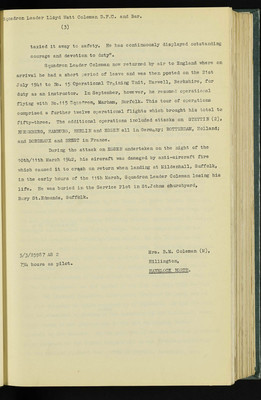Pages
21
William Cole was born in London on the 13th June, 1920, and received his secondary education at Wellington College where he obtained his School Certificate and Engineering Preliminary. He later atended the Wellington Tutorial School where he studied mathematics. He also attended night classes at the Wellington Technical College studying Chemistry, Mechanics and Physics. He was actively interested in football, boxing, cricket and swimming. He played for the College 1st XV and was runner up for the swimming championship. He was a member of the Lyall Bay Surf Life Saving Club. At the time of his making application for enlistment in the R.N.Z.A.F., he was apprenticed to William Cable and Co., Ltd., Wellington, Iron Founders and Engineers.
Sergeant Cole made application for aircrew training on the 11th September, 1939, and was enlisted at Levin on the 4th June, 1940. On satisfactorily completing his initial training he was posted to Ohakea, where, on the 18th October, 1940, he was awarded his air observer's badge, and on the 20th October promoted to the rank of Sergeant. On the 8th November, 1940, he embarked for the Middle East on the "Maunganui". During the voyage he was admitted to the General Hospital, Colombo suffering from mastoiditis, and discharged from hospital in January, 1941.
On arrival in Egypt, Sergeant Cole was posted, on the 4th February, 1941, to No. 70 Operational Training Unit, where he crewed up and completed his training, and thence, on the 3rd March, 1941 - to No. 55 Squadron operating from bases in the Western Desert, on Blenheim aircraft. With this Squadron he carried out a number of operations, the targets including Cappuzzo, Marble Arch, Derna, Benghazi, Tobruck and Gazala, in Libya; and Crete in Greece. He also bombed patrol barges and motor transport in the Tobruck-Capuzzo area.
22
W.D.L. COLE
- 2 -
On one occasion his aircraft was attacked by a C.E. 42.
Sergeant Cole was the Air Observer of a Blenheim bomber aircraft engaged on the 20th October, 1941 in a high level bombing attack on Gambut Aerodrome. This was his 21st operational flight. The formation with which he was operating was attacked by nemey fighters and his aircraft was forced to land on the water apptoximately 40 miles North of Gambut. In consequence all the crew, including Sergeant Cole, were classified as missing.
There was no further news of him and in due course his death was officially presumed to have occurred on the 20th October, 1941.
23
Lloyd Coleman was born at Wellington on the 10th December 1917 and received his secondary education at Wanganui Collegiate School where he passed the matriculation examination and during 1935 left New Zealand to enter Cambridge University. While a student at the University he joined the University Air Squadron and some three years later, having regard to the disturbed international outlook, he enrolled in the Royal Air Force Volunteer Reserve in which he was granted a commission as a pilot officer in the General Duties Branch with effect from the 31st January 1939. Subsequent to the outbreak of war he was on the 31 st July 1940 promoted to flying officer and on the 15th September 1940 promoted to flight lieutenant while his promotion to squadron leader was gazetted on the 12th March 1941. Meanwhile, after he had been granted his commission as a pilot officer, he proceeded with the peace time training of an officer in the Volunteer Reserve.
Following the outbreak of war, his training was intensified an on the 25th September 1939 he was posted to No.1 Initial Training Wing from where after a brief ground training course he was posted on the 22nd October 1939 to Cranwell Service Flying Training School, Lincolnshire. While here he was awarded his Flying Badge. He next proceeded on the 20th April 1940 to No.11 Operational Training Unit, Bassingbourn, Hertfordshire, to crew up and complete his training on Wellington bomber aircraft prior to being posted on the 17th January 1940 to No.149 Squadron and commencing operational flying As pilot of a Wellington bomber he took part in thirty operational flights including attacks on BREMEN (2), COLOGNE (2), HAMM (3), ROTTENBERG, SCHWARZ, KAMEN, HAMBURG, BOCHUM, HANNAU, BERLIN (4), KIEL (2), LEUNA and MUNICH all in Germany; the docks at Antwerp, Belgium and hangers at LE HAVRE, DUNKIRK, CALAIS and BOULOGNE in France. At the conclusion of this tour of operations, on the 20th November 1940, Squadron Leader Coleman was awarded the Distinguished Flying Cross, the citation reading as follows:
24
Squadron Leader Lloyd Watt Coleman D.F.C. and Bar.
(2)
"In November 1940, this officer was captain of an aircraft detailed to attack the railway yards and locomotive sheds at MUNICH. In spite of the fact that on his arrival he found considerable anti-aircraft activity and that he had been warned of the presence of balloons, he glided down to a height of 3,500 feet and straddled the target with his bombs. He then circled the town and ordered his airgunners to put out as many searchlights as possible Since June 1940, Flight Lieutenant Coleman has carried out twenty-five raids, fifteen of them as captain of aircraft, during which he has displayed skill, persistent determination and devotion to duty and has set a magnificent example to his squadron".
Early in December 1940 Squadron Leader Coleman was posted to No.3 Photographic Reconnaissance Flight, first at Oakington, Cambridgeshire, and later at Stradishall, Suffolk, for duty as a staff pilot. Then on the 11th February 1941 he left England by air for the Mediterranian on posting to No.148 Squadron, then at LUQA, MALTA, and later at KABRIT, Egypt. Resuming operational flying with this squadron he took part in a further eleven operations, bringing the total of his operations to forty-one. These additional operations comprised attacks on the enemy aerodromes at CATANIA, Sicily; BENINA and MENIDI (2) in the Western Desert; MALEME, Crete and an aerodrome on RHODES Island; together with attacks on enemy installations at TRIPOLI, EL ADEM and BENGHAZI (3) in CYRENAICA. His second tour of operations completed, on the 23rd May 1941 Squadron Leader Coleman was awarded a Bar to his Distinguished Flying Cross, the citation being:
"One night in May 1941, this officer was captain of an aircraft which carried out an attack on the aerodrome at BENINA. He displayed great skill and tenacity in locating his target and carried out his attackwith great determination, bombing and machine-gunning the aerodrome from different heights sometimes less than 1,000 feet. He destroyed at least two Junkers 52's on the ground and damaged others. Just after he had returned from his attack an incoming aircraft crashed and caught fire. Though the petrol tanks and bombs on the crashed aircraft were exploding, Flight Lieutenant Coleman ran to another aircraft standing nearby, started the engines and
25
Squadron Leader Lloyd Watt Coleman D.F.C. and Bar.
(3)
taxied it away to safety. He has continuously displayed outstanding courage and devotion to duty".
Squadron Leader Coleman now returned by air to England where on arrival he had a short period of leave and was then posted on the 21st July 1941 to No. 15 Operational Training Unit, Harwell, Berkshire, for duty as an instructor. In September, however, he resumed operational flying with No.115 Squadron, Marham, Norfolk. This tour of operations comprised a further twelve operational flights which brought his total to fifty-three. The additional operations included attacks on STETTIN (2), NUREMBERG, HAMBURG, BERLIN and ESSEN all in Germany; ROTTERDAM, Holland; and BORDEAUX and BREST in France.
During the attack on ESSEN undertaken on the night of the 10th/11th March 1942, his aircraft was damaged by anti-aircraft fire which caused it to crash on return when landing at Mildenhall, Suffolk, in the early hours of the 11th March, Squadron Leader Coleman losing his life. He was buried in the Service Plot in St.Johns churchyard, Bury St.Edmunds, Suffolk.
